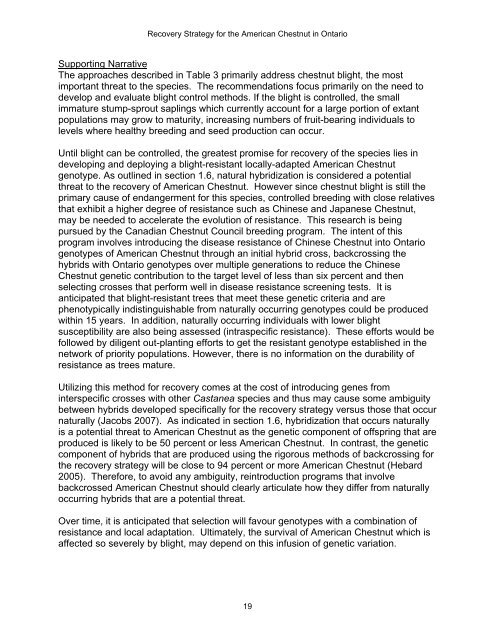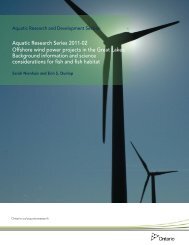(Castanea dentata) in Ontario - Ministry of Natural Resources ...
(Castanea dentata) in Ontario - Ministry of Natural Resources ...
(Castanea dentata) in Ontario - Ministry of Natural Resources ...
Create successful ePaper yourself
Turn your PDF publications into a flip-book with our unique Google optimized e-Paper software.
Recovery Strategy for the American Chestnut <strong>in</strong> <strong>Ontario</strong><br />
Support<strong>in</strong>g Narrative<br />
The approaches described <strong>in</strong> Table 3 primarily address chestnut blight, the most<br />
important threat to the species. The recommendations focus primarily on the need to<br />
develop and evaluate blight control methods. If the blight is controlled, the small<br />
immature stump-sprout sapl<strong>in</strong>gs which currently account for a large portion <strong>of</strong> extant<br />
populations may grow to maturity, <strong>in</strong>creas<strong>in</strong>g numbers <strong>of</strong> fruit-bear<strong>in</strong>g <strong>in</strong>dividuals to<br />
levels where healthy breed<strong>in</strong>g and seed production can occur.<br />
Until blight can be controlled, the greatest promise for recovery <strong>of</strong> the species lies <strong>in</strong><br />
develop<strong>in</strong>g and deploy<strong>in</strong>g a blight-resistant locally-adapted American Chestnut<br />
genotype. As outl<strong>in</strong>ed <strong>in</strong> section 1.6, natural hybridization is considered a potential<br />
threat to the recovery <strong>of</strong> American Chestnut. However s<strong>in</strong>ce chestnut blight is still the<br />
primary cause <strong>of</strong> endangerment for this species, controlled breed<strong>in</strong>g with close relatives<br />
that exhibit a higher degree <strong>of</strong> resistance such as Ch<strong>in</strong>ese and Japanese Chestnut,<br />
may be needed to accelerate the evolution <strong>of</strong> resistance. This research is be<strong>in</strong>g<br />
pursued by the Canadian Chestnut Council breed<strong>in</strong>g program. The <strong>in</strong>tent <strong>of</strong> this<br />
program <strong>in</strong>volves <strong>in</strong>troduc<strong>in</strong>g the disease resistance <strong>of</strong> Ch<strong>in</strong>ese Chestnut <strong>in</strong>to <strong>Ontario</strong><br />
genotypes <strong>of</strong> American Chestnut through an <strong>in</strong>itial hybrid cross, backcross<strong>in</strong>g the<br />
hybrids with <strong>Ontario</strong> genotypes over multiple generations to reduce the Ch<strong>in</strong>ese<br />
Chestnut genetic contribution to the target level <strong>of</strong> less than six percent and then<br />
select<strong>in</strong>g crosses that perform well <strong>in</strong> disease resistance screen<strong>in</strong>g tests. It is<br />
anticipated that blight-resistant trees that meet these genetic criteria and are<br />
phenotypically <strong>in</strong>dist<strong>in</strong>guishable from naturally occurr<strong>in</strong>g genotypes could be produced<br />
with<strong>in</strong> 15 years. In addition, naturally occurr<strong>in</strong>g <strong>in</strong>dividuals with lower blight<br />
susceptibility are also be<strong>in</strong>g assessed (<strong>in</strong>traspecific resistance). These efforts would be<br />
followed by diligent out-plant<strong>in</strong>g efforts to get the resistant genotype established <strong>in</strong> the<br />
network <strong>of</strong> priority populations. However, there is no <strong>in</strong>formation on the durability <strong>of</strong><br />
resistance as trees mature.<br />
Utiliz<strong>in</strong>g this method for recovery comes at the cost <strong>of</strong> <strong>in</strong>troduc<strong>in</strong>g genes from<br />
<strong>in</strong>terspecific crosses with other <strong>Castanea</strong> species and thus may cause some ambiguity<br />
between hybrids developed specifically for the recovery strategy versus those that occur<br />
naturally (Jacobs 2007). As <strong>in</strong>dicated <strong>in</strong> section 1.6, hybridization that occurs naturally<br />
is a potential threat to American Chestnut as the genetic component <strong>of</strong> <strong>of</strong>fspr<strong>in</strong>g that are<br />
produced is likely to be 50 percent or less American Chestnut. In contrast, the genetic<br />
component <strong>of</strong> hybrids that are produced us<strong>in</strong>g the rigorous methods <strong>of</strong> backcross<strong>in</strong>g for<br />
the recovery strategy will be close to 94 percent or more American Chestnut (Hebard<br />
2005). Therefore, to avoid any ambiguity, re<strong>in</strong>troduction programs that <strong>in</strong>volve<br />
backcrossed American Chestnut should clearly articulate how they differ from naturally<br />
occurr<strong>in</strong>g hybrids that are a potential threat.<br />
Over time, it is anticipated that selection will favour genotypes with a comb<strong>in</strong>ation <strong>of</strong><br />
resistance and local adaptation. Ultimately, the survival <strong>of</strong> American Chestnut which is<br />
affected so severely by blight, may depend on this <strong>in</strong>fusion <strong>of</strong> genetic variation.<br />
19
















